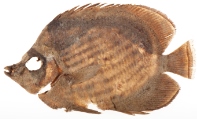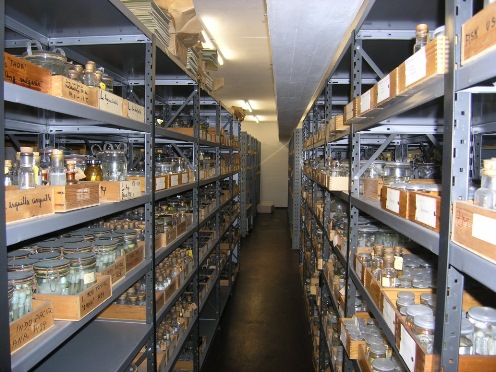Fish collection

Chaetodon faciatus Forsskål, 1775, from Forsskål's Herbarium.
Curator
Collection manager
About the collection
The collection of fishes is one of the more important of the large, old collections in Europe, going back to Forsskåls Fish Herbarium from 1761-1767.
The fish collection holds about one third of the 35,000 known species of fishes. Both fresh- and saltwater species from all over the world are represented. Some 250,000 specimens are registered. Especially rich collections come from the Danish marine expeditions "Ingolf", "Dana", "Atlantide" and "Galathea". The collection has plentiful material from Danish waters and former colonies such as Greenland and West Indies.
Fish collection in numbers
- Estimated number of specimens/collections: 500,000
- Types: c. 1,500
- Digitally available specimens: 250,000
- Percentage digitized: 50%
Strengths
- Large historic collection that dates 250 years back in time
- Types of species described by famous ichthyologists like Forsskål, Reinhardt, Kroyer, Lütken, Jensen, Bertelsen, Nielsen
- More than 1,500 types of fish species
- Good coverage of rarely caught deep sea taxa
- Tissue samples have been stored from all material collected since 1995
- High level of digital registration enables fast and easy search for species or particular specimens
Important subcollections/specimens/collectors
Forsskål's Herbarium
During the Danish expedition to the Red Sea "The Arabian Journey" (1761-1767) Peter Forsskål collected and described 151 species of fish. Today material of 65 of these species remain, of which 58 are types (cf. Klausewitz and Nielsen 1965). The collection consists of dried skins with a few remaining bones (Types from Forsskål's Herbarium can be found in The Type Collection Database).
Fishes from Greenland
Over the past 200 years fishes have been collected in Greenlandic waters. Consequently the collection holds representatives of almost all species reported from Greenland, often in large series. The material treated by Adolf S. Jensen is included here.
Larval fishes
This collection is dominated by larvae from tropical and subtropical coastal areas and from oceanic and deep-sea fishes – including many eel-larvae. By far the major part was collected during the "Dana" cruises by Johs. Schmidt.
Deep-sea fishes
The main sources are the "Dana" and "Galathea" expeditions. During the circumnavigation in 1928-30 the "Dana" used pelagic, fine-meshed gear, often down to about 1000 meters, which resulted in an exceptionally rich collection of both larvae and small, adult, mesopelagic fishes. During the circumnavigation in 1950-52, the "Galathea" used coarse-meshed bottom-gear down to the greatest depths, so the result is dominated by large bottom-living fishes.

